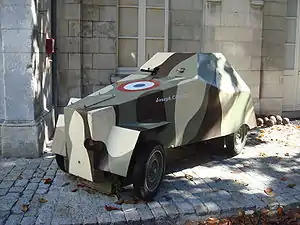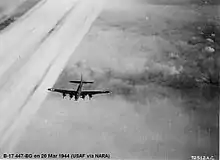Allied siege of La Rochelle
The Allied siege of La Rochelle occurred during the Second World War in 1944–45, when Allied troops invaded France.[1][2] La Rochelle was an important German naval base on the Atlantic for surface ships and submarines, from which U-boat campaigns were launched.[3]
| Allied siege of La Rochelle (1944–1945) | |||||||
|---|---|---|---|---|---|---|---|
| Part of World War II | |||||||
 French Army armoured car which participated in the liberation of La Rochelle in 1945. Musée d'Orbigny-Bernon. | |||||||
| |||||||
| Belligerents | |||||||
|
|
| ||||||
| Commanders and leaders | |||||||
|
|
| ||||||
| Strength | |||||||
| 22,000 | |||||||
La Rochelle and other harbours such as Royan and Saint-Nazaire, became "Atlantic pockets" still occupied by the Germans, which were bypassed by the main thrust of the Allied invasion, as was Dunkirk on the North Sea. The city was liberated only at the very end of the war, nine months after the Liberation of Paris, after the general German capitulation on 8 May 1945.
The siege (September 1944 – May 1945)
The pocket of La Rochelle ("Poche de La Rochelle"), one of the Atlantic pockets, was a zone extending to a distance of about 10 kilometers around La Rochelle, reinforced by an anti-tank trench. After the allied landing in Normandy in June 1944, a large number of German troops had regrouped in the area.
The allied siege of the pocket of La Rochelle lasted from September 1944 to May 1945, without heavy bombardment.[2][3] La Rochelle remained in German hands until the end of the war, much as other Atlantic harbours such as Brest, Saint-Nazaire, Lorient, Gironde-Nord, Gironde-Sud because the main thrust of the war was more concerned with focusing on Germany itself.[4] Just surrounding the city was considered wiser than conducting a frontal attack, as the city would ultimately fall anyway with the end of the war.[4] The German command also wished to keep control of the coastal garrisons and rejected evacuation in order to maintain a threat on Allied shipping in the Atlantic.[4]

In total 39,500 French civilians were under the rule of Vice-Admiral Schirlitz, who served as the Naval Commander Atlantic Coast, from 1943 in La Rochelle until the end of the war.[4][5] The German garrison numbered 22,000 men. During the siege the Allies still allowed for electricity, wood and some supplies to be delivered in order to alleviate the ordeal of the civilian population inside the walls of the city. Agreements were made between the French and the German occupation force in La Rochelle, to the effect that the French would not attack and that in exchange the Germans would not destroy the port installations of La Rochelle-La Pallice.[6]
In effect, La Rochelle was surrounded efficiently enough, and suffered enough from the siege, with harbour facilities being damaged by Allied air attacks, that the Germans were unable to launch major U-boat attacks on Allied shipping for the duration of the siege.[4] However, every week a Luftwaffe plane was able to break through the blockade and supply the garrison.[7] In order to raise the morale of German troops in La Rochelle, the propaganda movie Kolberg, celebrating resistance against the French in 1806, was sent in by Göring and premiered simultaneously in Berlin and La Rochelle on 30 January 1945.[8]
Allied offensive against German "Atlantic pockets"
From spring 1945, General De Larminat was put in charge of French forces in the region, with the objective of capturing La Rochelle.[7] The United States was to give logistical support as well as strategic air support.[7]
Operation Vénérable


The first city to be attacked was the nearby city of Royan, held by 5,500 German troops and inhabited by 3,000 French civilians. The city suffered a first strategic bombing on 5 January 1945 by the RAF, and then a massive attack by Allied troops under the French General de Larminat in Operation Vénérable on 14 April 1945, involving USAAF bombings on the 14th and 15th, bombardment by the fleet of Vice-Admiral Joseph Rue, and land attack by the 10th French Division and the 66th US Division.[9] The French command apparently had advocated that the French harbours should be retaken by military force, rather than awaiting their eventual surrender by the Germans. The city suffered heavy bombardment by 1,000 planes, including those of the USAAF's 447th Bomb Group,[10] with the result that the city was razed, and 1,500 civilians killed, in what has been described by the historian Howard Zinn as a "crime".[11][12]
Altogether, 27,000 artillery shells were fired over Royan, and the city saw one of the first military uses of napalm on 15 April 1945, dropped by Allied bombers, which made the city "a blazing furnace".[13]
Operation Mousquetaire
La Rochelle escaped this fate only because Royan was at the time considered a higher priority, due to its commanding position on the Gironde River. After Royan was taken, Ile d'Oléron was also captured in Operation Jupiter,[13] and de Larminat was planning to capture La Rochelle next in Opération Mousquetaire, but the plan was cancelled with the capitulation of Germany.
The French regiments that participated in the operations were under-strength units incorporating FFI elements: the 50th and 158th Regiments of the French 23rd Infantry Division (known as Division de marche Oléron), in conjunction with the French 2nd Armored Division and other elements.[14] The 4e régiment de Zouaves especially participated in the liberation of La Rochelle.
La Rochelle was one of the last French cities to be liberated in 1945.[15] It was surrendered to the Allies only on 7 May 1945,[3] with the surrender ceremony occurring on 8 May 1945, at 23:45. The Germans surrendered in Dunkirk on 9 May and Saint-Nazaire on 11 May.
Legacy

US troops would remain in the area around La Rochelle, within the dispositions of the Atlantic Alliance, at the bases of La Rochelle,[16] Croix-Chapeau, Bussac-Forêt,[17] and Saint-Jean-d'Angély (Fontenet) until 1966, when Charles de Gaulle withdrew France from the military wing of NATO, and ordered the closure of NATO bases in France.[18]
On 7 September 1996, a monument was established near the boundary of the La Rochelle pocket, near Saint-Sauveur-d'Aunis, the "Mémorial de la poche de la Rochelle", in memory of the soldiers who died in the operation.
Notes
- Dallas, Gregor. 1945: The War That Never Ended. p. 364.
- Avella, Natalie. The French Property Buyer's Handbook. p. 362.
- Barbour, Philippe (2004). France. Dana Facaros, Michael Pauls. p. 356. ISBN 9781860118814.
- Leitz, Christian (1996). Economic relations between Nazi Germany and Franco's Spain: 1936–1945. pp. 213ff. ISBN 0-19-820645-3.
- Duffy, Christopher. Red storm on the Reich: the Soviet march on Germany, 1945. p. 287.
- Zinn, Howard. The Zinn reader: writings on disobedience and democracy. p. 273.
- Stuart, Ilian. Provenance. pp. 252ff.
- Reimer, Robert C. Cultural History Through a National Socialist Lens. p. 59.
- Murfett, Malcolm H. Naval warfare 1919–45: an operational history of the volatile war at sea. p. 437.
- "447th Bomb Group Association". Archived from the original on 2009-01-06. Retrieved 2009-12-12.
- Zinn, Howard (1997). The Zinn reader: writings on disobedience and democracy. p. 275ff. ISBN 1-888363-54-1.
- Zinn, Howard. The politics of history: with a new introduction. p. 266.
- Zinn, Howard. The Zinn reader: writings on disobedience and democracy. pp. 278ff.
- "Stone&Stone Second World War Books".
- "La Rochelle Official Website".
- Huston, James Alvin (1990). Outposts and allies: U.S. Army logistics in the Cold War, 1945-1953. p. 93. ISBN 0-8386-3412-5.
- "Paul Louis Taylor, 66; Longtime Director of CBS News Programs". The Washington Post. February 8, 2008.
- Sorenson, David S. (2007). Military base closure: a reference handbook. p. 9. ISBN 0-275-99152-0.
.svg.png.webp)